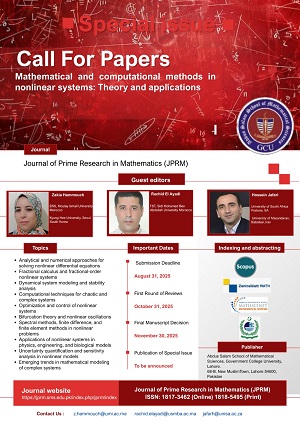New perspectives on Hepatitis C model with Piecewise Derivative: Deterministic and Stochastic Approaches
Keywords:
Hepatit-C model, piecewise derivative, stochastic approaches, existence and uniqueness.Abstract
In this paper, we have extensively explored deterministic-stochastic approaches of the Hepatitis C model using piecewise fractional operators techniques. This new concept leads us to capture many behaviors from cross-over to random processes. The piecewise differential operators that can be constructed from deterministic to stochastic patterns showed us their innovative aspects. To illustrate the effectiveness of the proposed approach, graphical representations for such a model are provided. As a result, it is concluded that these operators allow us to adapt more effectively to the realistic tendencies of real-world problems. Due to the property of capturing different behaviours at different time intervals, these operators have opened new doors for research in different disciplines.
Downloads
References
[1] Dietz, C., Maasoumy, B., 2022. Direct-acting antiviral agents for hepatitis C virus infection—From drug discovery to successful implementation in clinical practice. Viruses, 14 (6), 1325.
[2] Feinstone, S.M., Kapikian, A.Z., Purcell, R.H., Alter, H.J., Holland, P.V., 1975. Transfusion-associated hepatitis not due to viral hepatitis type A or B. New England Journal of Medicine, 292 (15), 767-770.
[3] Choo, Q.L., Kuo, G., Weiner, A.J., Overby, L.R., Bradley, D.W., Houghton, M., 1989. Isolation of a cDNA clone derived from a blood-borne non-A, non-B viral hepatitis genome. Science, 244, 359–362.
[4] Kuo, G., Choo, Q.L., Alter, H.J., Gitnick, G.L., Redeker, A.G., Purcell, R.H., Miyamura, T., Dienstag, J.L., Alter, M.J., Stevens, C.E., Tegtmeier, G.E., Bonino, M., Lee, W.S., Kuo, C., Berger, K., Shuster, J.R., Overby, L.R., Bradley, D.W., Houghton, M., 1989. An assay for circulating antibodies to a major etiologic virus of human non-A, non-B hepatitis. Science, 244, 362–366.
[5] Sadki, M., Danane, J., Allali, K., 2023. Hepatitis C virus fractional-order model: Mathematical Analysis. Modeling Earth Systems and Environment, 9 (2), 1695-1707.
[6] Maasoumy, B., Wedemeyer, H., 2012. Natural history of acute and chronic hepatitis C. Best practice & research Clinical gastroenterology, 26 (4), 401-412.
[7] Collaborators, H., 2017. Global prevalence and genotype distribution of hepatitis C virus infection in 2015: A modelling study. Lancet Gastroenterol. Hepatol. 2, 161–176.
[8] Duncan, J.D., Urbanowicz, R.A., Tarr, A.W., Ball, J.K., 2020. Hepatitis C virus vaccine: Vhallenges and prospects. Vaccines, 8 (1), 90.
[9] Larney, S., Peacock, A., Leung, J., Colledge, S., Hickman, M., Vickerman, P., Grebely, J., Dumchev, K.V., Griffiths, P., Hines, L., Cunningham E.B., Mattick R.P., Lynskey M., Marsden J., Strang J., Degenhardt L., 2017. Global, regional, and country-level coverage of interventions to prevent and manage HIV and hepatitis C among people who inject drugs: A systematic review. Lancet Glob. Health, 5, 1208–1220.
[10] Dayan, F., Ahmed N., Bariq A., Akgül A., Jawaz M., Rafiq M., Raza A., 2023. Computational study of a co-infection model of HIV/AIDS and hepatitis C virus models, Scientific Reports, 13, (1).
[11] Pitcher AB, Borquez A, Skaathun B, Martin NK. Mathematical modeling of Hepatitis C virus (HCV) prevention among people who inject drugs: A review of the literature and insights for elimination strategies. J Theor Biol. 2019, 21;481:194-201.
[12] Dahari H., Ribeiro RM., Rice CM., Perelson AS., Mathematical Modeling of Subgenomic Hepatitis C Virus Replication in Huh-7 Cells, 2007, Journal of Virology, 81, (2) , 750-760.
[13] Vujovic, V., Krstic, M., 2020. Stability of Stochastic Model for Hepatitis-C Transmission with an Isolation stage, Filomat, 34 (14), 4795–4809.
[14] Lestari, D., Adi-Kusumo, F., Megawati, N. Y., Susyanto, N. 2023. A minimum principle for stochastic control of hepatitis C epidemic model. Boundary Value Problems, 2023 (1), 1-12.
[15] Lestari, D., Megawati, N. Y., Susyanto, N., Adi-Kusumo, F., 2022. Qualitative behaviour of a stochastic hepatitis C epidemic model in cellular level, Mathematical Biosciences and Engineering, 19, 1515-1535.
[16] Topuz, C., 2021. Parameter estimation for stochastic differential equations, Dissertation, Ankara University, 33-34.
[17] Atangana, A., İğret Araz, S., 2021a. New numerical scheme with Newton polynomial: Theory, methods and applications, Elsevier, Academic press, ISBN:9780323854481.
[18] Caputo, M., Fabrizio, M., 2015. A new definition of fractional derivative without singular kernel. Progress in Fractional Differentiation & Applications, 1 (2), 73-85.
[19] Atangana, A., Baleanu, D., 2016. New fractional derivatives with non-local and non-singular kernel: Theory and application to heat transfer model, Thermal Science, 20 (2), 763-769.
[20] Atangana, A., İğret Araz, S., 2021b. New concept in calculus: Piecewise differential and integral operators, Chaos, Solitons and Fractals, 145.
[21] Wu, G.C., Deng, Z.G., Baleanu, D., Zeng, D.Q., New variable-order fractional chaotic systems for fast image encryption, Chaos, 29, 2019.
[22] Driessche, P.V., Watmough, J., 2002. Reproduction numbers and sub-threshold endemic equilibria for compartmental models of disease transmission, Mathematical Biosciences, 180 (1-2), 29-48.
[23] Steele, M.J., Stochastic Calculus and Financial Applications, Springer, 2010
[24] Atangana, A., İğret Araz, S., 2022c. Fractional stochastic differential equations applications to Covid-19 modeling, Springer.
Downloads
Published
Issue
Section
License
Copyright (c) 2025 İPEK KORKMAZ, Seda IGRET ARAZ

This work is licensed under a Creative Commons Attribution-NonCommercial-NoDerivatives 4.0 International License.






